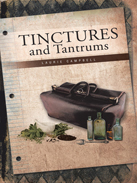"And now what was the truth? Was Hildegard ill? Was she mad? Was she possessed? Or was she just nasty?"

 |
Tinctures and Tantrums by Laurie Campbell Trafford Publishing
book review by C.D.
In the spirit of the iconic Masterpiece Theatre series Upstairs, Downstairs, Laurie Campbell presents a classic tale of the intertwining lives of aristocracy and the serving classes in this 700 page tome that completes the author's All Manor of Yarns, Prussian trilogy.
Central to this mid-nineteenth century literary soap are Otto von Goff, the kind, respected, wealthy landowner; his spirited 10-year old daughter, Luise; and his crazed, skeletal wife, Hildegard, with her lifeline of nerve tonics, potions, and "courage in a bottle" that leave her in a constant state of paranoia. It is a household filled with drama, pathos, and humor, complimented by a cast of maids, butlers, cooks, governesses, horsemen, and valets that cater to the von Goff's needs.
While there is a clear class distinction, Campbell highlights the co-dependency of one class to the other. Young Luise's desire to orchestrate a surprise birthday party for her father, solely comes to pass as a result of the cooperation of the hierarchy and the underlings. The resulting celebration is a grand triumph for all. There is also a strong female element to Campbell's storyline. Women often appear as the backbone in keeping both the village and estate households running, as one Frau declares "We women would never survive if we did only what the men think we do."
The author's use of the German dialect adds a cultural richness throughout the story. A glossary of German words and phrases, included at the end of the book, serves as a handy reference for those unfamiliar with the language.
With a sharp eye for detail, and a keen ear for dialogue, Campbell justly transports the reader to another place and time. But as we glimpse an earlier era, enmeshed with class problems, this fictional yarn clearly carries an enduring theme that could surely translate to contemporary times.